University Migrant Smart Hubs, Private Equity and The Leveraged Buyout of America
Resettlement, repurposed, and replaced may be the best way to sum up what is taking place at colleges and universities across the U.S. The protests are assisting as smokescreens to recreate the underbelly of these indoctrination camps, turning them into resettlement campuses, micro smart cities or “innovation districts,” and a funnel system for captured endowments that all leads to policy change and potential training grounds for agitators to bring the U.S. to its knees. This not only has a drastic impact on college students and so-called “higher education,” but on cities and towns that anchor these hubs, ultimately affecting everyone.
When you combine U.S. universities and colleges with Blackstone, private equity firms, Middle East investors, the UN, illegal immigrants, student housing, innovation districts, affordable housing, Jeffrey Sachs, college protest smokescreens, ECAR, Welcome Corps, corrupt billionaires, and mainstream news, you have a recipe for disaster – one that can only mean one thing – money is moving, the stage is being set, the infrastructure is being built, and control is shifting evermore into the hands of those who wish to destroy America.
This report will be broken down into 9 sections that all connect to show the bigger picture of this power grab:
• The Story in A Nutshell
• Trickery of The “Affordable Housing” Trend for Illegal Immigrants, Students, and Families
• Every Campus A Refuge (ECAR)
• Colleges and Universities Housing Illegal Immigrants
• Blackstone Acquired Largest Student Housing Company in The U.S., Partners with Over 100 Colleges and Universities and Plans to Hire 2,000 Refugees
• The U.S. Student Housing Market – Including Foreign Investors
• College and University Endowments Captured
• The Smokescreen: Israel-Hamas College Protests
• What’s The End Game?
Download this full report in PDF format from the Bookshop >
The Story in A Nutshell
This is a very short, cliff notes version to summarize the overall situation, while expanding on the evidence and details in the following sections. No detail should be overlooked in this entire report, as it covers several agendas that are all converging.
Illegal immigrants have been flooding into the U.S. for years, currently costing American taxpayers over $150 billion a year to assist them with housing, food, medical needs, in-state tuition, and more. That translates to every taxpayer contributing nearly $1,000 per year for this invasion. A U.S. Department of Health and Human Services 2024 report suggests that between 2005-2019 the government spent $457.2 billion on refugees and asylees. And people wonder why their property taxes and state taxes are going through the roof. Where are all of these illegal immigrants staying? How many were trained before coming here?
Most people are aware of city buildings, hotels, sports complexes, government compounds, or shelters where migrants have been bussed to, but there has been little talk about where some of them may permanently settle in. Over 65,000 Americans have signed up to sponsor immigrants in their homes, but that doesn’t even put a dent in it. When you have millions of people who need beds, that becomes a bit tricky.
It is estimated that well over 15 million illegal immigrants are now living in the U.S. and over 75,000 Special Interest Aliens (SIAs), who pose a national security risk to the U.S., have been released into the population. However, a Yale study that assessed the number of illegal immigrants living in the U.S. between 1990 and 2016 estimated over 22 million, so the actual numbers could be well over 30 million at this point. Where are they all housed?
Many of the immigrants are single men between the age of 18-24 – college and military age – traveling alone or in small groups, and many have ditched their IDs at the border before sneaking through. How easy it would be to blend in around college campuses. How many have made it into unchecked off-campus student housing to assist with protests, chaos, or future war tactics?
Colleges and universities decided long ago that it would be a great idea to create resettlement campuses for refugees on college campuses. In fact, Guilford College in North Carolina kicked it off in the U.S. under the establishment of “Every Campus A Refuge” (ECAR), which now has dozens of colleges and universities involved. This of course is compounded by sanctuary campuses, cities, and states, the Welcome Corps, Fair Housing laws that don’t allow landlords to ask if they are legal immigrants, or the fact that some states allow undocumented immigrants to qualify for in-state tuition. Add to that the new “innovation districts” or “smart cities” that are developing around major universities and it creates quite a compound, while they all vie for satellite campuses in the heart of D.C.
Many college and university campuses have been utilizing their dorms, gyms, or off campus student housing to house illegal immigrants and refugees, so much so, that the House passed the H.R. 3941 Students Not Shelter Act that was introduced on June 9, 2023, to prevent federal funding to K-12 schools and colleges who provided support and housing to migrants. It never would have made it past the Senate or Biden.
Let’s not forget the billions going into affordable housing, vouchers, section 8, rental assistance, built-to-rent homes, and sponsorship push that has been rolled out by the Biden administration over the years. The number of agencies, organizations, and “helpers” throughout the country (and outside the country) serving this agenda is just staggering.
What’s equally concerning is the fact that colleges and universities began divesting in higher education long ago while focusing their endowments on real estate and big equity partners. Over the years, this landscape has increased rapidly. When Blackstone acquires the largest student housing company in the U.S. with over 140,000 beds across 190 properties, that is a huge red flag, especially considering all of the other evidence. And when universities like the University of California Regents decides to give Blackstone $4 billion dollars for investments in real estate and student housing, that too raises concern. Hundreds of colleges and universities are tied in with Blackstone through investments, joint ventures, or “education” related. Harvard is about to take on Blackstone’s CFO to help steward their $50.7 billion endowment, beginning this July. When the Middle East is investing in U.S. student housing, that too is a huge red flag. And remember, off-campus student housing doesn’t necessarily mean the renter is actually attending the college.
While the Israel-Hamas war rages on, they strike while the iron is hot and rollout the necessary smokescreens to accomplish one of their major goals – to take more control over endowments, academics, campuses, real estate, policies, and install the key players they need to make this all happen and eventually create new legislation in their favor. The smokescreen? College protests making demands that the schools divest in Israel. This isn’t to say that protests aren’t warranted or that students are a part of this smokescreen, though there are some well-funded student organizations involved. You get all of the donors to call in and complain about how this is being managed and have mainstream media flood the news with protests everywhere, taking it across over 100 campuses in a single sweep, while big donors threaten to suspend funding. Begin with Columbia University, where Economist Jeffrey Sachs sits prominently on his SDGs platform preaching for his UN cohorts, only later to go on Tucker Carlson and spin a tale about how universities need more oversight because of research labs and funding due to the U.S. government’s inability to call for peace and their desire to rule the world. Using the word “neocons” 13 times while taking jabs at Victoria Nuland, who served under George W. Bush, Obama, and Biden in various positions, as well as Bill and Hillary Clinton, knowing those names would spark the fuel in everyone wanting to cheer him on for his so-called disclosure and “awakening.” And before you know it, schools are agreeing to hold meetings to discuss their investments and figure out solutions. See how that works?
None of this is about the war for these power thirsty maniacs. None of this is about peace. This is all about controlling the money flowing through every college and university, housing control, changing policies all the way up the ladder to reach legislation for further control, building smart city campuses and indoctrination camps, potentially establishing a strategic home base for illegal immigrants within campuses to assist with future events off campus, and dominating the U.S. After all, according to Jeffrey Sachs, everyone should be in fear of a nuclear war caused by the power hungry U.S. “neocons” in government, as well as the next plandemic. They certainly shouldn’t be concerned about Blackstone, BlackRock, Vanguard, BIS, Central Banks, his UN buddies, WEF, hundreds of corporations, and corrupt billionaire families that are the ones pulling all the strings. No, these will be the folks that come to “save the day.”
In simple terms:
1) Create resettlement camps for illegal immigrants
2) Buy up shuttered real estate near campuses as well as student housing companies
3) Create smokescreens to carry out agenda
4) Build innovation districts otherwise known as smart cities
4) Keep people distracted from the money moving around and smart city campuses expanding
5) Reconfigure oversight of endowments, change policies, academics, and eventually legislation
6) Control the indoctrination camps, immigrant camps, and money while implementing control grid
The Breakdown
Trickery of The “Affordable Housing” Trend For Illegal Immigrants, Students, and Families

This is an important aspect that ties into this entire scheme. The “Affordable Housing” push over lack of homes, increased mortgage rates and property taxes, skyrocketing homeowners insurance in some areas, and overall inflation, was all manufactured for home, land, and commercial real estate grabs by big financial firms to bring in a new wave of built-to-rent home communities and mixed use apartment complexes, more affordable off-campus student housing, and housing for illegal immigrants. Ultimately, this was done for the purpose of moving people into a control grid enslavement system where you own nothing and are “happy,” while they own everything. They become the landlord kings. And boy is it moving quickly. And, quite possibly to strategically house as many as 30 million illegal immigrants. Imagine that kind of power – to house and feed a person, provide safe passage and anonymity from police and ICE, tell them who to vote for, demand them to carry out whatever acts they may require or else – they get shipped back to their country.
The Biden administration wants to build two million “affordable homes” costing $258 billion dollars, to create more inventory, while 1.6 million of those homes are for rental purposes only. A new bill was just introduced by Reps. Adam Schiff and Jimmy Gomez, D-Calif., to convert unused government buildings into affordable housing, which includes a grant program “to help state and local governments convert properties into qualified residential rental projects.” They’ve had an incredible jumpstart with all of this, ever since the manufactured destruction of buildings across America with riots after the George Floyd scandal, during the tyrannical Covid lockdowns so they could buy up all the shuttered real estate.
Even shuttered schools are turning into “affordable housing apartments.” According to Forbes, converting abandoned schools into affordable apartments “is a trend a number of states and cities are embracing,” and Chicago seems to be leading the way in those efforts.
There has been a surge in new apartment complexes being developed across the U.S., which began in 2021 and is going stronger than ever. 2023 marked a 36-year high with 440,000 apartment units completed and 2024 is expected to complete another 670,000. Dallas, Phoenix, Austin, Denver, and New York are the top five cities planning big developments, with Atlanta, Houston, Charlotte, Los Angeles, and Newark not far behind. Greystar just moved into first place for the largest apartment owner in the U.S., and they also come in fourth place for holding the most student housing units.
Who to watch for in the single-family rental homes market, as far as the largest companies based on number of rental homes: Tricon Residential and Home Partners of America (parent company: Blackstone, top shareholders: Vanguard, BlackRock, Capital World Investments), Progress Residential (parent company: Pretium Partners, private company), Invitation Homes (top shareholders: Vanguard, Cohen & Steers, BlackRock), American Homes 4 Rent (AMH) (top shareholders: Vanguard, BlackRock, Norges Bank), Amherst Group( parent company: Amherst Holdings, private company), and FirstKey Homes (parent company: Cerberus Capital Management, private company). Those alone account for over 400,000 rental homes and Invitation Homes intends to buy up thousands more this year. It’s best to rent from individuals who maintain ownership of the house rather than large corporations who don’t have people’s best interest at heart.
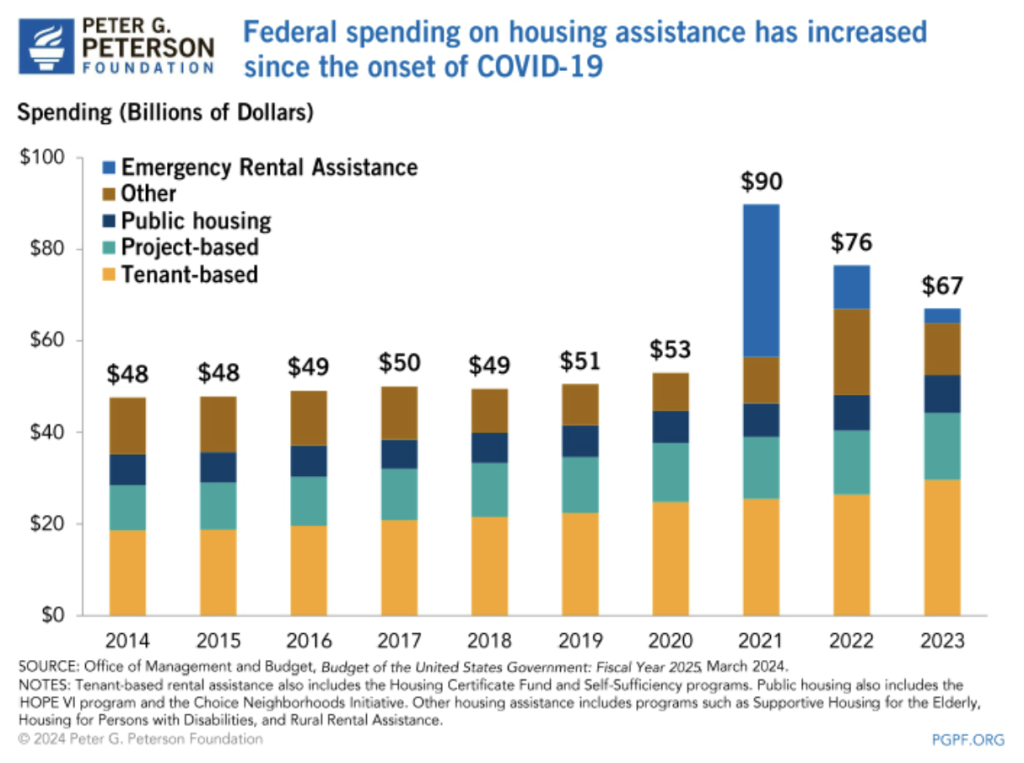
On April 13, 2023, the U.S. Department of Housing and Urban Development (HUD) announced the availability of $30.3 billion for the Housing Choice Voucher (HCV) Program for 2023, with a historic $2.9 billion (10.5 percent) increase over the prior year. Six months later, HUD expanded more rental assistance to 800,000 households across 65 metropolitan areas, including higher-rent neighborhoods, to give voucher holders a wider selection of homes to choose from.
On May 7, 2024, HUD “revitalized” the Housing Voucher Program with a new rule to reduce barriers in the Housing Choice Voucher (HCV) and Project Based Voucher (PBV) programs, while also reducing regulatory burdens on Public Housing Agencies (PHAs) to rapidly increase Affordable Housing supply. HUD states that “PHAs can tie long term federal PBV rental assistance to specific units or developments rather than to a tenant and project owners can secure additional private and public financing by leveraging the PBV assistance.” They can also pair PBV assistance with manufactured housing. How much does the U.S. spend on housing vouchers? The federal government spent $67 billion on housing assistance in 2023 alone. In 2021, it spiked up to $90 billion. Whereas vouchers may be helpful to those in need, it should be noted that the underlying intention is to make people reliant on the government to one day move everyone to a universal basic income and healthcare so that choices and decisions are no longer available to individuals, and all spending and actions become monitored and controlled.
Here is a 49-page HUD document containing the complete list of all public housing authorities by name, with their 2024 prorated eligibility after offsets, for housing choice voucher contract renewals. Here are just a few samples of HUD announcements on billions of dollars going out to states in January, February, and two from May, just to provide a few reference points.
How do you work affordable housing into student housing to move everyone onto vouchers, be able to cover the cost of housing illegal immigrants, merge everyone into being reliant on the government for universal income, education, housing, and healthcare? One way is to jack up the rent at student housing facilities so high that “advocates” come in to argue their case so new policies, regulations, zoning and development, and legislation can fall into place. That’s what’s happening in real time right now on the student housing scene. Some of the largest student housing companies have been sued for inflating rent, drawing attention to this issue.
Some states have passed laws allowing community colleges to build affordable housing for students. Due to housing insecurity for college students, increasing after the plandemic, it seems many community colleges are looking to build student housing.
Under a new law in California, community colleges and churches can now bypass local zoning regulations and build affordable housing units. NBC News reported that “Rev. Zachary Hoover of faith-based group LA Voice says about 20 congregations have already expressed interest in building some 2,000 apartments on their land,” who also suggested that this needs to be done so communities won’t have to deal with encampments. That’s guaranteed money in their pockets.
States and the federal government, via taxpayer dollars, are subsidizing this massive Affordable Housing trend that includes everything from rezoning to a myriad of housing vouchers, Section 8, rental fees covered for illegal immigrants in some states, built-to-rent homes, converting shuttered schools and office buildings into affordable housing mixed-use apartments, and so on. Once you get enough people reliant on the government and plugged into the control grid, it’s all down hill from there.
Every Campus a Refuge (ECAR)
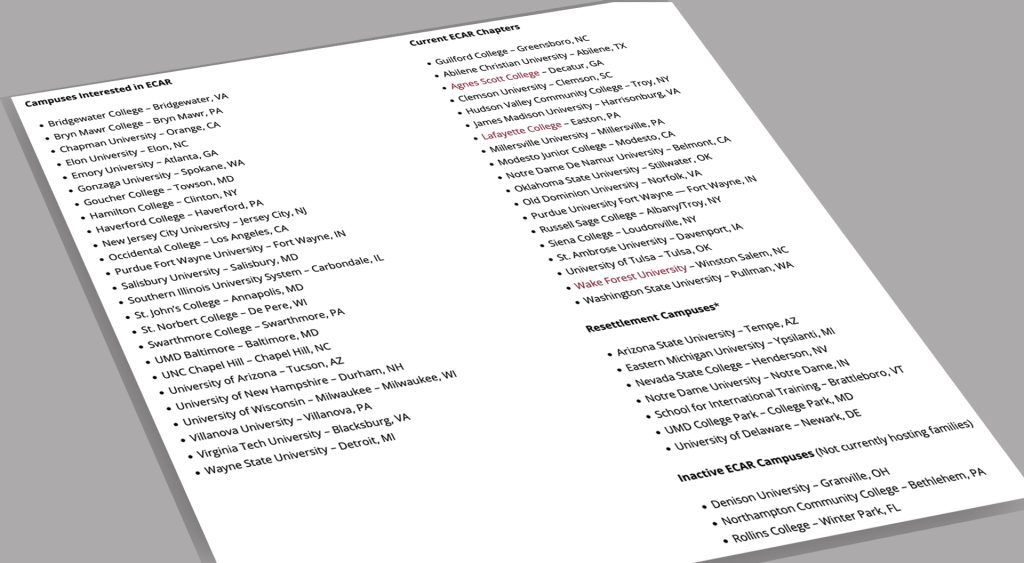
According to the United Nations, “resettlement campuses are the future of higher education.” ECAR, Every Campus A Refuge, was founded at Guilford College in North Carolina, by Dr. Diya Abdo, in September of 2015, after being inspired when Pope Francis called on every European parish to host one refugee family. At least, that’s how the story is told. According to ECAR’s website, they would like to see every college and university in the world partner with local refugee resettlement agencies to house refugees on campus grounds. Their website states, “the idea is that university and college campuses have everything necessary – housing, food, care, skills – to take in refugees and support them as they begin their lives in their new homes.” Essentially, they refer to them as “small cities,” which of course are loaded up with smart tech.
Guilford College and Every Campus A Refuge were invited to be part of the United Nations’ Together Campaign and its Summit held on January 9, 2018, which focused on how colleges and universities around the world can take action to aid in the global refugee crisis. Nine colleges and universities (from the U.S., the U.K., Brazil, Cyprus, Humboldt University in Germany, and the University of Science and Technology in China), along with Guilford College, signed the UN Together Campaign Action Charter pledging active support for refugees and migrants’ safety and dignity. UNICEF, UNHCR, and IOM were of course part of the panel. ECAR’s site indicates that just six months later, at the second UN Together Campaign Summit, “39 other institutions attended, sharing practices on supporting refugees and migrants with a special focus on UN Sustainable Development Goal # 16 – Peace, Justice and Strong Institutions: “Promote peaceful and inclusive societies for sustainable development, provide access to justice for all and build effective, accountable and inclusive institutions at all levels.” Watch the founder of ECAR speak about how college campuses can help house and assist refugees in the short video on their page, here. In one photo they show the University of Massachusetts and Amsterdam University College on their “projects to promote SDG 16 Case Studies” slide. In another, they show the University of Pennsylvania along with universities in Greece and Spain.
The Together Initiative launched on September 19, 2016 when all 193 member states of the UN committed to strengthening the “social contract between host countries and communities, and refugees and migrants.” The goal was to run until mid 2018 when all member states were expected to adopt two Global Compacts on Refugees and Migrants.
ECAR provides a handy map (below) for colleges and universities to find their nearest refugee resettlement agency. Now, in some cases these are actual refugee families who are welcomed at the airport by a resettlement agency, temporarily housed (5-8 months) in campus houses or apartments with free rent, utilities, Wi-Fi, food, use of the facilities and support, and then moved to off campus housing. But who really determines who is going where and who is getting in? And, in the case of floods of illegal immigrants bussed into cities, who is considered a refugee?
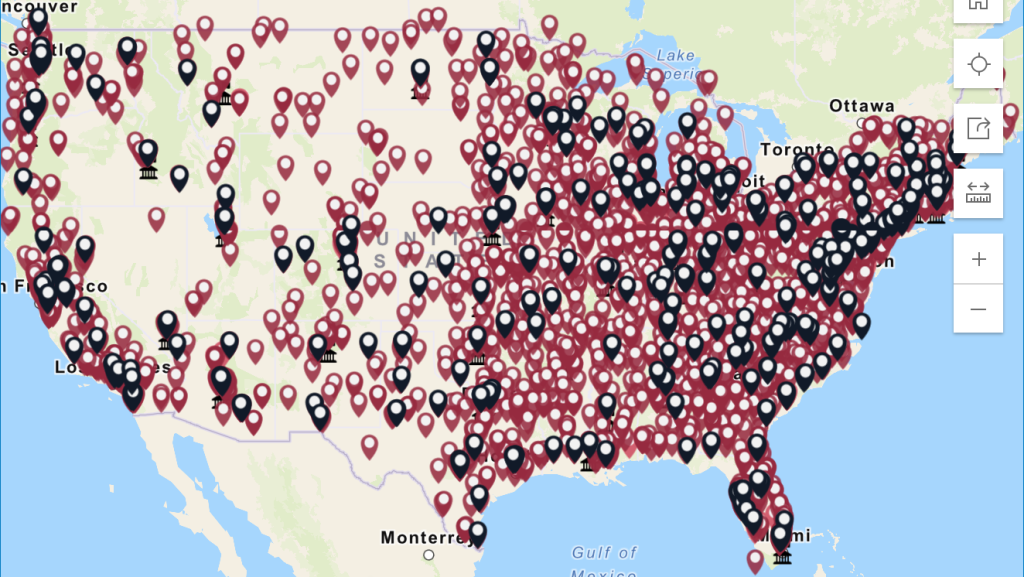
According to ECAR, they have created a 16 credit minor where minor students will learn about “what creates refugees, centralize refugee voices and experiences, train in how to organize around and advocate for refugee issues, create and implement projects that assist refugees, and work with refugees hosted by ECAR.” In other words, these colleges and universities that are housing refugees and migrants are training and conditioning students on how to assist them and advocate for them.
Since its inception, ECAR has campuses actively hosting refugees, including Lafayette College, Wake Forest University, Old Dominion University, Russell Sage College, and Siena College among others, with more mobilizing to do so. ECAR has 19 colleges and universities that have formed chapters across 14 states, an additional 25 colleges and universities are interested in ECAR, and 7 colleges and universities that have not signed a licensing agreement with ECAR are also providing resettlement campuses, including Arizona State University, Eastern Michigan University, Nevada State College, and Notre Dame University. See the full list here.
The Obama Administration’s U.S. State Department certainly assisted with their “Toolkit for Universities Helping Refugees,” which highlights ECAR. And, the 2016 college protests for sanctuary campuses increased the odds as well.
None of this is to say that there aren’t legitimate refugees that need assistance, or that people in the U.S. shouldn’t help those families, but there are major agendas at play and nefarious actors involved, and this isn’t about a few thousand families, it is about a massive invasion with as many as 30 million illegal immigrants.
Colleges and Universities Housing Illegal Immigrants

Some might recall the uproar in 2022-2023 when multiple public school gyms and colleges and universities began housing illegal immigrants in dorms, gyms, conference centers, student housing, or anywhere they could accommodate them, whether school was in session or not. The news may have fizzled out but the assistance sure hasn’t.
Tuition fees have gone through the roof over the past couple decades in the U.S., making it difficult for many to attend college, especially in a time of manufactured inflation. Additionally, since 2016, over 100 private non-profit and public colleges and universities have either closed, merged, or announced plans to, while over 50 for-profit colleges and universities have closed or were acquired just between 2016 and 2018. What will become of those campuses that closed?
408,000 unauthorized immigrants attend college in the U.S. Of course, each state has their parameters as to what qualifies them for in-state tuition and the history of this evolvement is quite complex. Once considered to be a resident, while still undocumented, it opens the floodgate for state financial aid and grants to assist with room and board, tuition waivers, stipends, scholarships, and beyond.
To move things along, On July 6, 2023, the Welcome Corps announced its launch of the Welcome Corps on Campus. The Welcome Corps is a U.S. private sponsorship program that the U.S. Department of State launched in January 2023 for refugees that came through the U.S. Refugee Admissions Program (USRAP). In a first-of-its kind program, the Welcome Corps on Campus, through USRAP, allows colleges and universities to enroll refugee students in degree programs to provide a permanent legal status in the United States, all while fostering more “diverse and inclusive campuses.” Their announcement goes on to state, “The Welcome Corps on Campus builds on that tradition and increases the United States’ resettlement capacity while leveraging campus ecosystems as welcoming communities, where refugee students have access not only to education, but also essential resettlement services including housing, healthcare, and social services…Through the Welcome Corps, sponsor groups welcome refugees into local communities and directly assist refugee newcomers as they build new lives in the United States.” They provide a complete list of the 149 “diverse institutions and organizations” that will help provide an “education pathway to citizenship for refugee students.”
The list includes:
African Communities Together
Agnes Scott
Airbnb.org
Alight
American International College
Antioch College
Arizona State University
Augsburg University
Bard College
Bennington College
Berkshire Community College
Broward College
Bryn Mawr College
Bunker Hill Community College
California State University Fullerton
Carleton College
Carnegie Mellon University
Center for Migration and the Global City, Rutgers University-Newark
Center for Refugee, Migrant, and Displacement Studies at Virginia Tech
Central Washington University
Cerritos Community College District
Charles R. Drew University of Medicine and Science (CDU)
Church World Service
Clovis Community College
Colby College
College of Saint Mary
Colorado College
Colorado State University
Colorado State University Global
Colorado State University Pueblo
Colorado State University System
Community Sponsorship Hub
Connecticut State Colleges & Universities
Contra Costa College
Contra Costa Community College District
Cornell College
DePaul University
Diablo Valley College
Dominican University
Eastern Connecticut State University
Educational Testing Service
Elena’s Light INC
Elon University
EnglishUSA
Ethiopian Community Development Council
Every Campus A Refuge
Exodus World Service
Five Together Foundation
Foothill College
Foothill-De Anza Community College District
Georgetown University
Grand Valley State University
Guilford College
Hamilton College
Hello Neighbor
HIAS
Home for Refugees USA
Institute for Holocaust and Genocide Studies
Institute of International Education
International Institute of St. Louis
International Refugee Assistance Project
International Rescue Committee
IRIS – Integrated Refugee & Immigrant Services
Ithaca College
Jefferson Community and Technical College (JCTC)
Jesuit Refugee Service/USA
KenSAP
Lewis University
Los Medanos College
Louisiana Organization for Refugees and Immigrants
Loyola Marymount University
Loyola University Maryland
Marymount University
Massachusetts Institute of Technology
Metro State University
Metropolitan State University of Denver
Middlebury College
Middlesex Community College/MA
Montgomery College
Mount Holyoke College
Mt. Hood Community College
Muina International Solutions Inc
NAFSA: Association of International Educators
National Association of System Heads
New York University
Niskanen Center
Northern Arizona University
Northern Essex Community College
Oklahoma State University
One Refugee
Pace University
Pairity
Pomona College
Presidents’ Alliance on Higher Education and Immigration
Queens University of Charlotte
Rainbow Railroad
Re-Imagining Migration
Refugee & Migrant Education Network
Refugee Congress
Refugee Council USA (RCUSA)
Refugee Welcome Collective
Refugees International
RefugePoint
RewirED
Rochester Institute of Technology
Roosevelt University
Rutgers University-Camden
Rutgers University-Newark
Saint Joseph’s College of Maine
Salem State University
Salt Lake Community College
Salve Regina University
School for International Training
School of the Art Institute of Chicago
Seattle University
Southern New Hampshire University
St. Edward’s University
Stockton University
Suffolk University
SUNY Cortland
Tarjimly
TESOL International Association
The University of Connecticut
Towson University
Toyota Technological Institute at Chicago (TTIC)
Trinity College
UC San Diego
University of Michigan – Dearborn
University at Albany, SUNY
University of Dayton
University of Denver
University of La Verne
University of Massachusetts Boston
University of Minnesota – Twin Cities
University of Redlands
University of San Diego
University of the District of Columbia
University of Tulsa
USAHello
Virginia Wesleyan University
We Are All America
WeaveTales
Welcome.US
WelcomeNST
Welcoming America
World Education Services
World Learning
World Relief
World University Service of Canada
In addition to this, numerous states have provided rental assistance to migrants for “temporary housing.” Illinois, for example, has provided $9,000 over a 6-month period to cover moving, rent for an apartment or house, and furnishings. Catholic Charities, one of the biggest organizations to provide assistance to illegal immigrants across the U.S., assists with securing the housing. While people see massive property tax hikes across Illinois, Gov. Pritzker has allocated billions toward assisting illegal immigrants. The question is, which apartments or “affordable homes” are housing them?
Meanwhile, over in Brunswick, Maine, they are building apartments for migrants to live in free for two whole years. By January, 2024 they had already completed 24 units with a plan to have 60 in total. Maine’s State Housing Authority implemented this program. A 52-unit complex in South Portland was also providing housing.
The Department of Homeland Security (DHS) distributes billions of dollars to cities receiving migrants. It’s tough to even keep up with the press releases. DHS’s notice of funding opportunity for fiscal year 2024 Shelter and Services Program, provides a list of those receiving funds from a $300 million award. Under the allocations column, Catholic Charities across multiple states accounts for over $40 million of the pie. World Hunger and United Way are also on the list.
A Snapshot of Just a Handful of Colleges and Universities Housing Illegal Immigrants that don’t fall under the new student refugee program to obtain citizenship:
It’s probably safe to say that nearby, off-campus student housing of illegal immigrants may not be publicized, and would be handled more discreetly. For example, Kent State University in Ohio is hoping to become an ECAR campus, but in the meantime, they are in talks with local landlords and apartment complexes close to the university, to find pro bono spaces for refugees. Off-campus student housing buildings and apartment complexes are owned by big financial institutions and private developers, typically not the schools. Therefore, tracking how many illegal immigrants may be getting “pro bono spaces,” utilizing vouchers, or behind the scenes exchanges and shenanigans, is difficult to do. That said, the public-private partnership between universities and developers has been increasing over the years to where some companies are developing new student housing facilities and operate the facilities on a partnership fee while the universities handle the finances, leasing, and marketing.
• American Musical and Dramatic Academy in Manhattan, New York, received a $109 million multiyear contract to move students out of its dorms to make way for asylum seekers. At least 600 single immigrant adults were placed in the dorms in June of 2023. They later transferred those migrants to another shelter and moved 50 families into the dorms to remain throughout the school year. By September, 2023, NYC Health and Hospitals had committed almost $2.2 billion in contracts pertaining to migrants. Since April, 2022, over 180,000 migrants have arrived in New York, as far as what they have actually tracked.
• The University of Massachusetts stated last August that they too were going to provide shelter to migrants, offering up dorms and a conference center. As of August, 2023, over 80 communities were housing migrants in Massachusetts.
• Eastern Nazarene College in Quincy, Massachusetts is also housing migrants, costing $237K a month, which may extend through 2025. Massachusetts project it would spend $932 million in 2023 and $915 million in 2024 on shelter-related services.
• Salem State University in Salem, Massachusetts is housing migrants as well, in its South Campus. Thousands of migrants have arrived in Massachusetts just in the past two years.
• Chicago housed hundreds of migrants at Wilbur Wright College and Richard J. Daley College. Many of those migrants were eventually moved to the American Islamic College Campus in Uptown, which can house between 500-600 people. The American Islamic College is looking for a new campus in Chicago and the building where migrants are being housed is to eventually be turned into high-rise apartments and senior living. Since August, 2022, Chicago has welcomed over 42,000 migrants by bus or plane, which doesn’t include those arriving independently.
• The University of California San Diego is helping to build a massive long term shelter for migrants in Northern Baja, California. The facility will have housing, kitchens, educational programs, job training, and recreational facilities, as well as provide jobs for migrants on the property.
This isn’t just happening in the U.S. Other countries are fulfilling the same playbook. In the UK, students were forced out of their luxury housing block because the Home Office decided to rent the development for migrants. Over 400 asylees moved into Huddersfield student accommodations, leaving 150 students to find alternative places to stay. Of course, the UK is also seeing students protest at university campuses over the Israel-Hamas war. Between mid 2019 and mid 2023 over 100,000 migrants had crossed the Channel into the UK. In Ireland, over 3,000 refugees were housed on college campuses at one point, and it seems the battle is still going on over housing migrants in student housing on college campuses and potentially purchasing buildings to repurpose for migrants. These are just a few examples.
Blackstone Acquired Largest Student Housing Company in The U.S., Partners with Over 100 Colleges and Universities and Plans to Hire 2,000 Refugees

On April 19, 2022, Blackstone Group, the world’s largest alternative asset manager with more than $1 trillion in AUM, acquired American Campus Communities (ACC) for $12.8 billion dollars, which is the largest student housing company in the U.S. ACC currently boasts 205 properties in 71 leading university markets including Arizona State University, California – Berkeley, Florida State University, and The University of Texas at Austin. They account for over 144,000 beds. ACC owns, manages, and is a developer of student housing communities. They are not simply a management company. ACC is currently in the process of developing six new student housing communities opening this year, plus four more in 2025. They are heavily focused on ESGs (environmental social governance), diversity, equity & inclusion.
Blackstone is the world’s largest landlord. They have bought up apartment blocks, student housing, single-family housing rental companies, senior care homes, offices, hotels, logistics warehouses, data centers, and film studios, with over 300,000 units of rental housing in the U.S. Blackstone is known for jacking up rents, causing evictions, and being a poor landlord. Just this May Blackstone acquired Tricon Residential’s 38,000 rental homes, increasing its inventory of single-family rental homes to 66,000 in the U.S.
It should come as no surprise that the Blackstone Group’s top three shareholders are Vanguard, BlackRock, and Capital World Investors. BlackRock was originally under the same umbrella company as Blackstone Financial Management, founded in 1985, but in 1988 BlackRock separated from the parent company. Corey’s Digs has reported extensively on BlackRock’s history and involvement with ESGs, digital IDs and blockchain, financial takeover, CEO Larry Fink, and most importantly on August 22, 2019, BlackRock’s white paper on “Going Direct,” which reveals that the central bank has been moving funds directly into the hands of public and private sector spenders (meaning equity investors), in a laundering scheme. The plan injected more than $5 trillion into the U.S. financial system. The following month, the U.S. Federal Reserve began a repo loan bailout program by “Going Direct” to the trading houses on Wall Street, and in March 2020, hired BlackRock to help implement the “Going Direct” plan.
Blackstone partners with the Tent Partnership for Refugees (known as TENT), founded in 2016 by Chobani owner Hamdi Ulukaya. Over 400 companies across the globe partner with TENT to commit to hiring and integrating 36 million refugees. Through this partnership, in 2022, Blackstone committed to hiring 2,000 refugees across its global portfolio companies and real estate properties by the end of 2025. Blackstone stated that they “will continue to partner with its portfolio companies, third-party property managers and joint venture partners to support refugee hiring efforts.” As a side note, Starbucks committed to hiring 10,000 refugees over the course of five years between 2017 and 2022. Surely, everyone can guess who the top shareholders of Starbucks are – Vanguard and BlackRock.
Blackstone’s LaunchPad, a program run by the Blackstone Charitable Foundation, has worked with 78 campuses since its inception, produced $62 million in grants, and 40,000 students participated in 2023 alone, according to their site. They provide both in-person skills-building programs as well as online. While they teach growth mindset, creativity, and critical thinking and leadership, they also bring them under their wings or their partners’ wings to mold them and build relationships through their internship programs across Blackstone’s network of portfolios. Blackstone works with dedicated campus directors and faculty to run these programs.
Washington State University, who is part of ECAR, is working with Blackstone on 10-week 2025 internships where students can learn all about ESGs and “fully immerse themselves in Blackstone’s culture.”
After a close 15-year relationship with Blackstone, and having already invested $2 billion with them, the University of California partnered with Blackstone’s Real Estate Income Trust on January 3, 2023 with a $4 billion dollar investment with a focus on student housing, staff and faculty housing, and affordable housing. More on this under the Endowments section.
The University of California system of schools is a common theme throughout this report, as they plug into nearly every section pertaining to Blackstone, endowments, student housing, protests, and illegal immigrants. In addition to California becoming a sanctuary state in 2017, as well as the many ways California has worked to benefit illegal immigrants over their own homeless population, in 2023 a coalition of undocumented students requested that UC ignore a federal law (INA Section 1324a) that prohibits employing undocumented foreign students. After UCLA law school’s Center for Immigration Law and Policy decided that the law doesn’t apply to state universities, on May 18, UC said they would put out the “now hiring” sign. In January, 2024, student activists launched a hunger strike because UC had yet to hire undocumented students.
Last year, Blackstone-owned Packers Sanitation Services, Inc. (PSSI) was embroiled in a child labor scandal, employing more than 100 children to clean equipment at meat packing plants across eight states. Some of the children were as young as 13, tending to brisket saws, bone cutters, and skull splitters at JBS Foods, Tyson Foods, and Cargill. Blackstone paid $1.5 million in fines to the Department of Labor for oppressive child labor. Some folks may want to think twice about purchasing meat from these big corporations, all of whom have been covered in Corey’s Digs reports. Supporting local farmers is always best.
The U.S. Student Housing Market – Including Foreign Investors
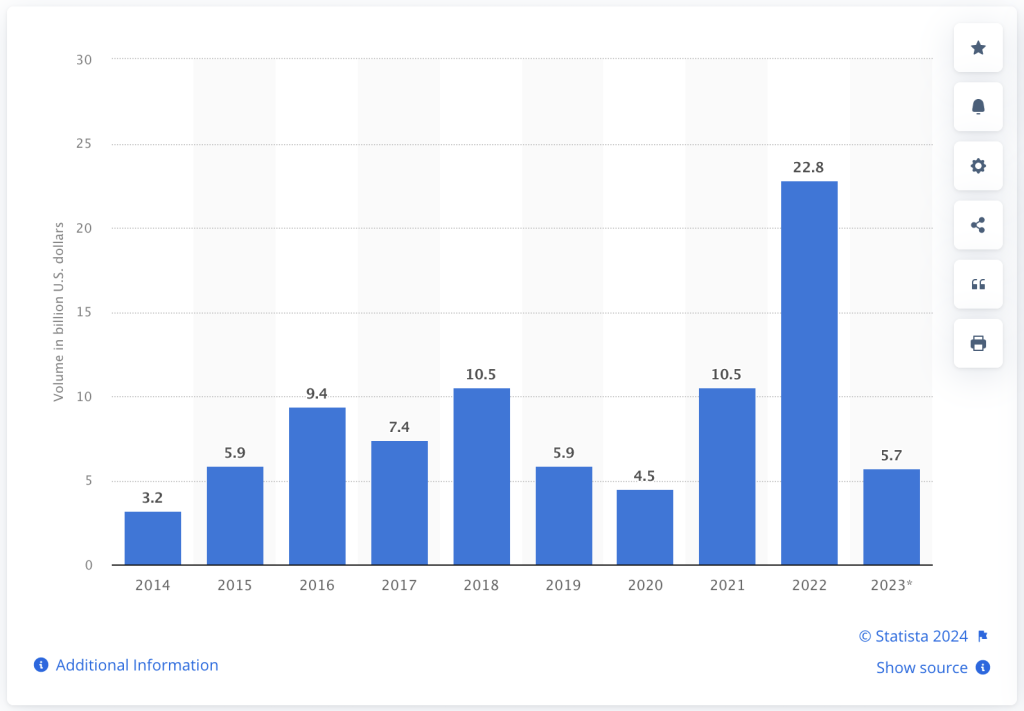
The chart above indicates the value of investment transactions in student housing in the U.S. from 2014 to 2023.
In addition to Blackstone acquiring the largest student housing company in the U.S., the industry itself appears to be booming. The top five largest student housing real estate companies in the U.S. are American Campus Communities (owned by Blackstone), The Scion Group, Greystar Student Living, Cardinal Group, and Asset Living. Other big ones in the running include Landmark Properties and Harrison Street Capital. After Blackstone acquired 19 student housing properties in a joint venture with Greystar back in 2018 for $1.2 billion, on April 25, 2024 Blackstone sold them to KKR & Co Inc. for $1.64 billion. The over 10,000-bed portfolio comprises 19 student housing assets located in 14 four-year public universities across 10 states.
A lot of real estate transactions go down in the student housing market. There is a steady flow of building, acquiring, and selling taking place. One example is Harrison Street recently sold 37 student housing properties across 19 states and 31 universities to a UK company (GSA) and others in a joint venture. Back in 2018, they sold 22 properties to Canada Pension Plan Investment Board and a Singapore company. Oh yes, foreign companies are very interested in U.S. student housing real estate.
Nearly eight million students require student housing near campus in the U.S. and studies have shown they want single occupancy with all the mixed use amenities and smart features, which is a perfect fit for micro smart cities. Roughly 22% of university students live in on-campus dorms and residence halls, 23% live in off-campus student housing, and 55% choose nearby rentals.
In a 2021 National Multifamily Housing Council white paper on The Future of U.S. Student Housing Demand, they stated that one-third of Americans rent their housing and 15% live in an apartment. In regards to student housing, they stated that only 4% of the units built over the past decade were double occupancy and that it will be important to have smaller units going forward for purposes of isolating individuals if necessary. They expressed that “the ability to relocate and quarantine students will become increasingly important as the role of buildings in public health policy gains renewed emphasis and is supported by new technologies.” They also stressed the need for public-private programs to improve building quality and projected that student housing will grow from 8.5 million beds in 2020 to 9.2 million by 2031.
According to a 2023 Berkadia report, effective rent growth across the top universities rose 7.9% between August 2022 and August 2023, which is more than three times the rate of market-rate rent growth across the country.
2024 is expected to be a solid year for the student housing sector, with an average occupancy rate of 95% across the top universities, and an expected enrollment of 19.25 million students.
In January, 2023, the Student HOMES Coalition was created by higher education advocacy organizations and students from colleges and universities across California, to fight for “affordable, accessible, and abundant student housing opportunities.” They are currently advocating for four California Bills: Senate Bill 312 would allow for public colleges and universities to bypass the state’s strict environmental review process when building student housing. Assembly Bill 3116 would allow both schools and developers to get around development restrictions in order to build larger, low-income student housing. Assembly Bill 2785 would put a cap on rental application fees and receive a refund if not selected. Assembly Bill 2801 would ensure that landlords use security deposits on reasonable damages rather than upgrades when a renter moves out.
On June 6, 2024, the University of California Berkeley won a Supreme Court ruling to build new student housing at Berkeley’s 3-acre People’s Park. The $312 million housing complex will be able to accommodate 1,000 students AND up to 125 for homeless, low-income residents.
Not to state the obvious, but California has a host of programs to help illegal immigrants, aside from the sanctuary campuses, cities, and state.
Foreign Investors Buying and Building U.S. Student Housing
Below is just a handful of foreign investors expanding their real estate portfolios in the U.S., with eyes on the student housing sector. Is this a good investment or is there more to it?
• In 2021, London-based Global Student Accommodations (GSA) and Morgan Stanley Real Estate Investing announced a joint venture to become leaders in the student housing market. GSA had an existing portfolio with close to 15,000 beds across 21 states. In 2022, through their joint venture, they purchased five additional student housing properties from Harrison Street, adding another 1,600 beds and expanding to a total of 23 states.
• In July, 2022, GFH Financial Group, a Middle East investment group out of Bahrain, and its subsidiary Student Quarters, based in Atlanta, GA, acquired a $300 million student housing portfolio in Michigan, Missouri, and Texas through U.S.-based SQ Asset Management (SQ). They later acquired a majority stake in SQ. GFH’s goal in the student housing market is to focus on the top 150 public universities in the U.S.
• Middle East investors are not just focused on student housing, they are also buying up medical clinics, office buildings, and other real estate in the U.S.
• In August, 2022, U.S.-based Landmark Properties announced a build-to-core joint venture with Abu Dhabi Investment Fund, to build student housing next to the largest universities in the U.S., after creating a $1 billion venture together in March to purchase existing student housing properties.
• In 2022, Saudi Arabia-based company Riyad Capital, partnered with The Ascott Limited to develop student housing properties in the U.S., under the name Student Accommodation Development Venture (SAVE). The Ascott is owned by Singapore-based CapitaLand Investment Limited, whose parent company is Temasek. Their first investment was to build a new 779-bed student housing community near the University of Nebraska-Lincoln. Corey’s Digs has reported on Temasek in four previous reports. Temasek is involved with Bill Gates and others who are invested in lab grown meat, partnered with Monsanto/Bayer to launch a $30 million startup called Unfold to develop vegetable seeds for vertical farms, and are part of a $3 trillion WEF initiative with Open Society Foundations, Rockefeller Foundation, United Nations, Wellcome Trust, Bezos Earth Fund, and more, to tackle climate change.
Public-private partnerships between universities and developers of student housing have also been growing. They negotiate deals where developers get an ongoing cut from student’s payments. There have been a lot of scheming and scams with some of these partnerships. During the plandemic when they kicked students off campuses, this resulted in a lot of students getting stuck paying on a lease because the developers wouldn’t let them out of them or refund them, and the universities had no say in the matter. Some universities settled these issues but took a hit.
There have also been plenty of lawsuits against student housing and management companies price-fixing rents, among other schemes.
College and University Endowments Captured

It was 1988 when hedge-fund manager Tom Steyer convinced David Swensen, Yale’s endowment manager, to invest $300 million into Steyer’s new fund, Farallon Capital, that forever changed how endowment funds were managed. Other universities began investing in private equity and real estate hedge funds. Billionaires and alumni contribute their tax-deductible donations to pump up these investments by universities who are primarily tax-exempt. Between 1990 and 2021, the average endowment value grew by 423%. The plandemic served as an opportunity to increase endowment size by 35% alone during 2021, due to the booming stock market.
Between 2018 and 2023, 49 four-year private schools of higher eduction and 16 four-year public institutions have purchased office buildings because the rate of available office buildings jumped to 24% after the plandemic, and were far more affordable to scoop up. Colleges and universities have also acquired hotels and other real estate.
Priorities shifted, and instead of higher education for students being a top priority, it became all about making a return on investment. Wall Street has been lining their pockets, billionaire donors have been calling the shots, and in the end – the students lose.
The system has been rigged for a long time. Their are countless books and reports on how higher education institutions have been utilizing their endowments to make money that benefits the donors, Wall Street, and others, while leaving little to assist the students students or their education.
As of 2023, the top 20 largest endowments for higher education institutions in the U.S. were:
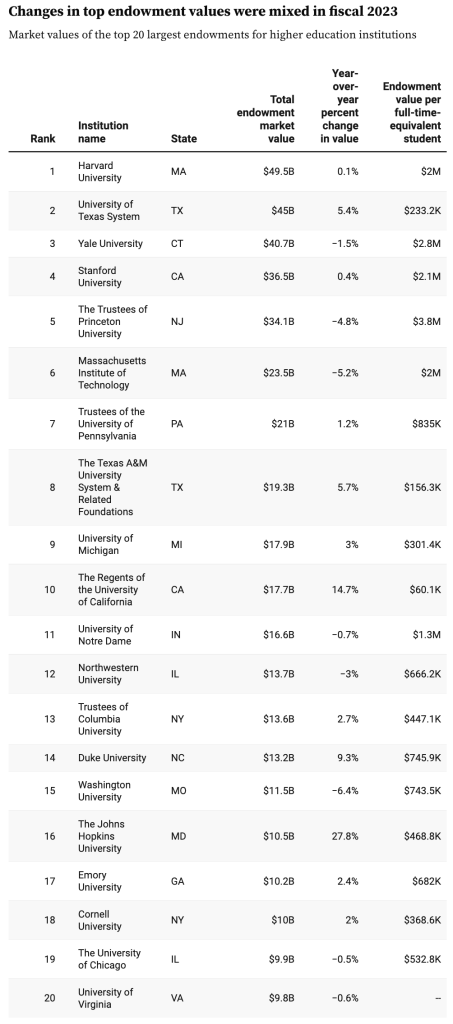
Table: Natalie Schwartz/Higher Ed Drive – Source: 2023 NACUBO-Commonfund Study of Endowments
College “Innovation Districts” or Strategic Migrant Campuses?
Billions from these endowments are going toward real estate. In many cases, universities are buying up shuttered nearby office buildings, but instead of converting them as an extension of the campus for academia, they are turning them into retail space to create “innovation districts,” or “innovation ecosystems.” It’s the equivalent of a 15-min city with all the bells and whistles of smart tech for a digital control grid. As the Brookings Institute put it, they are “the ultimate mash up of entrepreneurs and educational institutions, start-ups and schools, mixed-use development and medical innovations, bike-sharing, and bankable investments – all connected by transit, powered by clean energy, wired for digital technology, and fueled by caffeine.”
By “wired for digital technology,” they are referring to all public places in the “innovation district” being “created or re-configured to be digitally-accessible” with wireless networks, top notch fiber optics and internet, and computers and digital displays embedded into spaces. They also suggest streets being “transformed into living labs” where they can test out new fun digital technologies and fancy street lighting. And, they emphasize the need for governance of each district. Of course micro-housing and any needed rezoning is all part of the package. And all of this includes expanding into neighborhoods and the broader metropolis.
Universities have been gobbling up commercial real estate and partnering with developers for some time. In fact, universities are the largest employers in two-thirds of America’s 100 largest cities.
Some folks will look at this, especially many from the younger generation, and think “how convenient,” as they walk around their surveilled prison blocks.
These hubs are already taking shape at the University of California at Davis, the University of Texas at Austin, Arizona State University, Georgia Tech, and the University of Washington, just to name a few. They are creating the hubs around higher education institutions in cities such as Atlanta, Baltimore, Buffalo, Cambridge, Cleveland, Detroit, Houston, Philadelphia, Pittsburgh, St. Louis, San Diego. This is a global agenda, with “innovation districts” already underway in Barcelona, Berlin, London, Medellin, Montreal, Seoul, Stockholm, and Toronto.
Deloitte likes to refer to them as a “Smart Campus – The next-generation connected campus,” which essentially reads much like the Brookings Institute paper. Deloitte’s 2019 paper emphasizes that “smart banking, smart retail, smart digital workplaces, and smart venues like hospitals and stadiums could be extended to higher eduction campuses.” Deloitte defines these campuses as a paradigm shift that creates a digital culture to collect data, provides digitally augmented reality and virtual reality technologies, drives revenue streams, and acts as a model for testing so as to improve upon it and expand to surrounding communities and cities. They’re baking quite the cake, and the icing is that they want to deploy RPA, blockchain, location intelligence, venue analytics, and chatbots. It sure sounds like a fun campus!
An excerpt from the Smart Cities Association states that “essentially, college campuses are becoming must-watch landscapes for trends that resemble those of smart cities. Like many local governments, a growing number of colleges and universities have hired Chief Information Officers (CIOs) to coordinate smart, secure innovation and technological systems throughout campus. Northwestern University, Boston College and Dartmouth College are among the many schools that have CIOs, and Stanford University just created a CIO position this year.”
Here’s the real question: Are they focused on building “innovation districts” or “15-minute cities” for purposes of the digital control grid, and eventually expanding out to cities and regions, while also housing illegal immigrants and continuing with the indoctrination of students, or is it for the purpose of blending trained illegal immigrants into campuses at strategic locations across the country for future actions since they make the perfect micro cities to operate from and blend into? Or, is it a combination of both? No matter the case, one thing is for certain – endowments have long been used as another transfer of wealth while escaping taxes, partner with private equity firms, and continue to buy up real estate – all while students remain the least of their concern.
According to the Private Equity Stakeholder Project’s 2019 partial list of Blackstone investors, the following colleges and universities invested with Blackstone that year:
Aga Khan University Foundation Endowment
Berkeley Endowment Management Company
Clemson University Foundation Endowment
Colby College Endowment
Colgate University Endowment
Denison University Endowment
Indiana University Foundation Endowment
Michigan State University Endowment
Nevada System of Higher Education Endowment
Regents of the University of California
University of Houston System Endowment
University of Michigan Endowment
University of Missouri Endowment
University of South Dakota Foundation Endowment
University of Texas Investment Management Company Endowment
University of Toronto Asset Management Corporation Endowment
University of Washington Endowment
UC Investments’ Strategic $4 Billion Venture with Blackstone
In January, 2023, the Regents of the University of California (UC Investments) and Blackstone announced a strategic long-term (6-year hold) venture with a $4 billion commitment from UC Investments in Blackstone Real Estate Income Trust, Inc. (BREIT) class 1 common shares. In doing so, Blackstone then contributed $1 billion of its BREIT holdings as part of a venture with UC Investments. UC Investments has held a 15-year-long partnership with Blackstone and had already invested $2 billion. This of course provides ample cash flow for Blackstone. Though this only adds up to $6 billion, as reported by other sources, according to a recent statement by UC’s Chief Investment Officer Jagdeep Singh Bachher, they’ve actually invested $8.6 billion with Blackstone, to date, as well as nearly $2.3 billion with BlackRock.
UC Investments’ co-heads of real estate intend to work closely with Blackstone portfolio companies, with a focus in student housing, staff and faculty housing, and affordable housing in California.
Shortly thereafter, UC contributed an additional $500 million to Blackstone, and received backlash from the university’s union for investing in corporate landlords who drive rent up and increase evictions. In an open letter signed by all of the major unions to UC’s CIO Jagdeep Singh Bachher, they stated, “As one of the largest landlords in California, the University of California already bears significant responsibility for this crisis. However, through this new partnership with Blackstone Inc., the University will become a major driver of this affordability crisis for the UC community and the rest of California.” The letter is a must read, as it documents the major issues and concerns with private equity firms, such as Blackstone, buying up homes and student housing, and taking hold of the rental market. When you combine this manufactured crisis with the affordable housing scheme it becomes quite evident that this is a coordinated play for full control over all housing, because – “you will own nothing and be happy.”
Several of UC campuses, including UC Irvine, also outsourced portions of their student housing to American Campus Communities, which Blackstone acquired in 2022 as documented above.
Here is a 35-page 2023 list of the University of California’s Real Property Report which includes the dates, land, structures, and costs of all property owned, going back over a century, for those who may be interested. Here is the 2022-2023 annual report on the university’s private support.
Outsourcing Management of Endowments is The Name of The Game
Harvard’s endowment is the largest in the country and will likely only get larger after tapping Blackstone’s chief financial advisor, Michael S. Chae, who will become a member of the Harvard Management Company’s (HMC) board of directors beginning on July 1, 2024. The board currently consists of 10 members which are responsible for managing Harvard’s $50.7 billion endowment. HMC is led by CEO N.P. “Narv” Narvekar, who joined in 2016 after being CEO at Columbia University since 2002, and by 2017 launched a new strategy to outsource assets to external managers. Narvekar had carried out the same strategy at Columbia. Harvard began outsourcing management of most of its endowment by mid 2017. They laid off half of their investment staff and utilized the endowment’s direct real-estate team as an external manager. In 2018, Harvard sold its portfolio of over 100 warehouses to Blackstone.
As far back as 2015, universities such as Yale, Harvard, University of Texas, Stanford, and Princeton were all spending more of their endowment on private equity fund managers than they were on their students. Yale, for example, paid $480 million to private equity fund managers while only spending $170 million on tuition assistance, fellowships and prizes on students in 2014. That following year, co-founder of Blackstone, Stephen A. Schwarzman, pledged $150 million to Yale for a new student center. This has become a concerning trend among colleges and universities.
Billionaires have been funding and steering university endowments for years. Between 2010 and 2020, The Bill & Melinda Gates Foundation granted over $11.6 billion to 471 universities and higher education institutions in 66 countries, with over 70% going to U.S. universities. The top five in order of funding were: University of Washington, John Hopkins University, Emory University, University of California, San Francisco, and the University of Oxford. Bill Gates is merely one example.
Outsourcing management of endowments isn’t the only game in town. The plandemic brought on an onslaught of billions of dollars in outsourcing to for-profit companies to manage everything from online courses, enrollment and recruiting, tutors, research, manage IT, dorms, classrooms, labs, parking, and even student unions. Getting the big picture?
It’s not just the private equity firms eating up these endowments. In 2020, the University of Illinois System invested almost $160 million of their endowment to become the first investor in BlackRock’s new environmental, social and governance (ESG) strategy, which goes along with the UN’s Sustainable Development Goals, furthering these agendas.
Location is Key: Satellite Campuses in D.C.
In addition to buying up real estate surrounding campuses, many colleges and universities are expanding their campuses to other cities as satellite campuses, with over 50 already in Washington D.C., the prime location they all seek. Millions of dollars are going into these expansions.
According to James Birkey, senior vice president for education at real estate company JLL, universities have established satellite campuses for a long time but “what is new is the competitive tenor of it.” Birkey explains that “there are key institutions that are looking for very specific space in specific strategic places, and the economics are currently in their favor to find it.”
In 2018, Arizona State University opened its new center just four blocks from the White House, and expanded to another nearby building the following year. Not long after, the University of Arizona acquired space just two blocks from the White House.
Just in 2023 alone, new outposts and expansions took place by Texas A&M, Purdue, Princeton, and Johns Hopkin’s who spent $372 million to acquire the former Newseum building for its new Bloomberg Center.
The University of Southern California recently purchased an office building on Dupont Circle in Washington D.C. to convert to a satellite campus. USC President Carol L. Folt said, “the idea of creating a campus structure in D.C. came up pretty recently. It really came to fruition quickly.”
Small private schools and large public schools all want the D.C. action, including New York University,
Middlebury College, Florida International University, the University of Pennsylvania, and Hillsdale College, just to name a few.
In order to accommodate all of these students, more housing will be needed, which means purchasing office buildings or other real estate to convert into student housing.
It goes without saying that D.C. Mayor Muriel Bowser is 100% for these satellite campuses and wants to expand university uses, reimagine the downtown, add a large tech hub and office to residential conversions, plus add an additional 15,000 residents downtown.
The Smokescreen: Israel-Hamas College Protests

Whereas many students are protesting because they are truly disturbed by this war and the mass murder of thousands of adults and children, there are aspects of these protests that have been coordinated for a different cause so as to create a massive smokescreen while the universities and billionaires move pieces into play, and professionally funded agitators are part of their game. From new “hate crime” legislation to a changing of the guard at universities and further capturing their endowments and controlling policies, from land grabs to housing illegal immigrants and strategizing next moves – everything is on the table. Meanwhile, thousands are being slaughtered abroad and the invasion at the U.S. borders continues while the media is primarily focused on the protests. Smokescreen.
Most people know by now that protests popping up across the globe at hundreds of universities is not organic. Organizations and groups are trained activists and are well funded. Some students have been trained to be a part of it, others are trained agitators to kick them up a level. And sure, there are many students that follow suit because they feel it is a just cause. War is certainly going to stir emotions and create rage and passion in people, and with good reason, but there is much more going on than meets the eye.
Over 100 colleges and universities have protested in the U.S. alone, some involving encampments. The message heard around the world at universities is the same – “divest in Israel.” It’s a key message that likely originated with activist groups funded by big players, because it points the finger at endowments and more importantly, who manages those endowments, in order to shake things up and move key people into place.
Two organizers of protests on multiple campuses are IfNotNow and Jewish Voice for Peace, which are both supported by the Tides Foundation. The Tides Foundation supports all kinds of nonprofits working for social change, and are funded by George Soros. A spokesperson for George Soros’ Open Society Foundation said that it “has funded a broad spectrum of US groups that have advocated for the rights of Palestinians and Israelis and for peaceful resolution to the conflict in Israel.”
David Rockefeller Jr. has given almost $500,000 to Jewish Voice for Peace through the Rockefeller Brothers Fund, and funds the Tides Foundation as well. Susan and Nick Pritzker fund a foundation that is supporting groups involved in pro-Palestinian protests.
But the bigger picture is the billionaire philanthropists and big donors to university endowments who have been threatening to cease their funding over these protests. Columbia University has already seen millions suspended by big donors. This has been one of the bigger focus points of the media frenzy, stirring things up on the financial scope and management of endowments. When donors can dictate how a university should act, respond to situations, hire or fire top personnel, and spend its funding, the university’s priorities are not about the students, and it’s been going on for a very long time.
When Clinton friends such as Lawrence Summers turns on his own in a public display, it’s always a good idea to pay attention. His job was to focus on targeting Harvard for not condemning a statement made by pro-Palestinian students. The following day, billionaire hedge fund manager Bill Ackman also put on a public display requesting that Harvard release the list of members who were involved with the statement to ensure that no one would ever hire them. This of course put the newly appointed president in the hot seat, bringing a pile-on from many directions, including a congressional hearing, in which Harvard President Claudine Gay later resigned. M. Elizabeth Magill, president of the University of Pennsylvania also resigned just a few days after she appeared before Congress, and hedge fund manager Ross Stevens threatened to withdraw a $100 million donation. Columbia University’s president managed to hold her position despite Columbia professors, lawmakers, and students calling for her resignation.

But it was American Economist and Columbia University Professor Jeffrey D. Sachs’ appearance on Tucker Carlson’s show that revealed the underbelly of their agenda while setting the stage for the destruction of America. For those who believe it was anything but trickery, they are not familiar with Jeffrey Sachs. Few people are as connected as Jeffrey Sachs, or as involved as he has been in agendas against humanity. From his Harvard leadership in the rape of Russia to the creation of the Global Fund which has full immunity, and Sachs himself called for $10 billion a year just ten days before the first alleged Covid case hit the U.S., he spearheaded the bogus Harvard Consensus Statement on antiretroviral treatment for AIDS, his coziness with Pope Francis, his decades-long relationship with the UN and belief of “human-induced climate change,” are pretty good indicators of where Sachs is coming from. Just take a look at an older Columbia University archive of his 40-page resume of accomplishments to glean how long Jeffrey Sachs has been in this game. He’s no dummy, nor is he naive, as he pretended to be in this interview.
Jeffrey Sachs spent an hour and forty-five minutes mystifying people with digs at universities, government, war, Victoria Nuland, and the Clintons, while simultaneously suggesting nuclear war is on the horizon, and that he was speaking out about all of this because of his concern for his children’s futures. This, coming from a man who has plotted with the best to bring America to its knees. Yet, people bought into it because he hit on the key words that resonated with everyone’s frustrations and anger. Sachs is a very useful tool. Let’s break it down:
• Nothing Sachs said is new information. This wasn’t a disclosure of any kind.
• He pushed the threat of nuclear war twelve times to ensure he invoked a state of fear while listeners clung to his every word, making them more vulnerable to any hopeful tidbits he tossed out.
• He intentionally appeared humble, acted naive – even calling himself naive several times, and even frightened.
• He made it a point to complain about how universities and big donors are all part of this corrupt system, despite the fact he was and is a big part of this system and has carried out incredible agendas against humanity.
• He targeted the U.S. government and used the term “neocons” thirteen times while leaving out the obvious bad players and declaring that the UN is about bringing peace, when in fact, they are about control and enslavement. He also targeted the Clintons and Nuland to make it more believable.
• He dodged Tucker’s question about the pandemic treaty and instead stoked more fear around Covid and about a future pandemic, which is all convenient for the UN. As chairman and leader of the Lancet Covid-19 Commission, he has distracted and mislead Congress and citizens about Covid and pushed for mass vaccination, universal health coverage with pandemic preparedness plans, a new Global Health Fund for more money, and to achieve the Paris Agreement and the UN Sustainable Development Goals.
• This quote by Sachs is two-fold. “We got a shit show going on in this country right now. If a university thinks it can do whatever it wants, and if NIH has a different opinion and we have no rules and they’re doing work on dangerous pathogens. Yeah, we’re going to have another pandemic.” What he is doing there is opening the door for more oversight and changing of the guard over universities and their endowments, while at the same time trying to manifest more fear in people around a pandemic.
• Once again, another quote by Sachs dogging universities shows the need to better oversee their financial management and opens the door for a rearranging of oversight so as to put in key players, alter policies, create new legislation, and so on. “I mean, it’s not a shock to tell you, but all of these special organizations, the think tanks or university special departments or research units, they’re funded by the U.S. government. They’re funded by the security state. They’re funded by large donors that are all part of this story,” said Sachs. This is comical coming from Sachs.
• Coincidentally, Columbia University was center stage for the protests, encampment, and even arrests over the Israel-Hamas war, drawing a lot of attention and inspiring other universities to follow suit. Over 100 faculty members from Columbia and Barnard protested in support of students, condemning their suspensions and arrests.
Deescalation and Negotiations
To deescalate the situation and shut down encampments, several schools such as Brown University, Northwestern University, and Evergreen State College in Olympia, Washington, made agreements with students regarding a review of their investments with Israel without promising divestments. Other schools followed a similar strategy including Rutgers, Johns Hopkins, University of Minnesota and the University of California, Riverside. Some schools also pledged aid for Palestinian students and the improvement of space for Muslim students on their campuses.
Students at the University of California called for the university to divest in weapons manufacturers, Blackstone, BlackRock, companies that support Israel, and a couple dozen other companies. This request would amount to one-fifth of the system’s assets, equating to $32 billion, according to UC Chief Investment Officer Jagdeep Singh Bachher. UC Regents said it’s not so simple.
Students at several universities are calling for divestment from Google, Amazon and Airbnb for profiting from “Israel apartheid, genocide and occupation in Palestine.” If anyone believes that any university would divest from Google or Amazon, they are mistaken. In August, 2023, Amazon announced plans to invest $7.2 billion in Israel, launching its Amazon Web Services data centers so that Amazon’s cloud services could assist with Israel’s government applications, local data centers, and workloads.
The same message echoes across the world at other colleges. Protesters at the University of Groningen in the Netherlands were sharing banners on social media stating their demands to “disclose, boycott, and divest.” The same message carried through to the University of Amsterdam where 120 protesters were arrested when violence broke out. Protesters at the encampment at the University of Toronto in Canada called for the same transparency of investments and divestment from Israeli weapons companies. The University of Calgary protesters had their encampment removed by police after a barrage of tear gas and flash bangs.
Sanctuary Campuses and Comparative Maps
The map seen below shows over 80 colleges and universities who were protesting for Sanctuary Campuses back in 2016. This proposed that schools will not allow Immigration and Customs Enforcement (ICE) officers onto campus without a warrant or share student immigration status with ICE, police are not allowed to enforce immigration law, providing tuition support to students with DACA status, expanding policies to include medical, and more. The American Association of University Professors urged colleges and universities to adopt sanctuary policies and endorsed this movement on November 22, 2016.
Portland State University and Reed College were the first to declare their campuses a sanctuary campus. Other higher education institutions followed suit by self-declaring their campuses a sanctuary, including New York University, Columbia University, Wesleyan University, Oregon State University, Pitzer College, Santa Fe Community College, University of Pennsylvania, Connecticut College, Drake University, and Swarthmore College. Numerous other schools declared protective policies for illegal immigrants, including Rutgers College, California State University, Iowa State University and Haverford College. The UK and Ireland have also followed suit at some of their schools.
Now imagine, sanctuary campuses, which would include student housing, essentially housing and protecting illegal immigrants with absolutely no law enforcement aware that they are even located there. Then throw in sanctuary cities and states. Whether or not any of this is legal doesn’t seem to matter to politicians and presidents of universities.
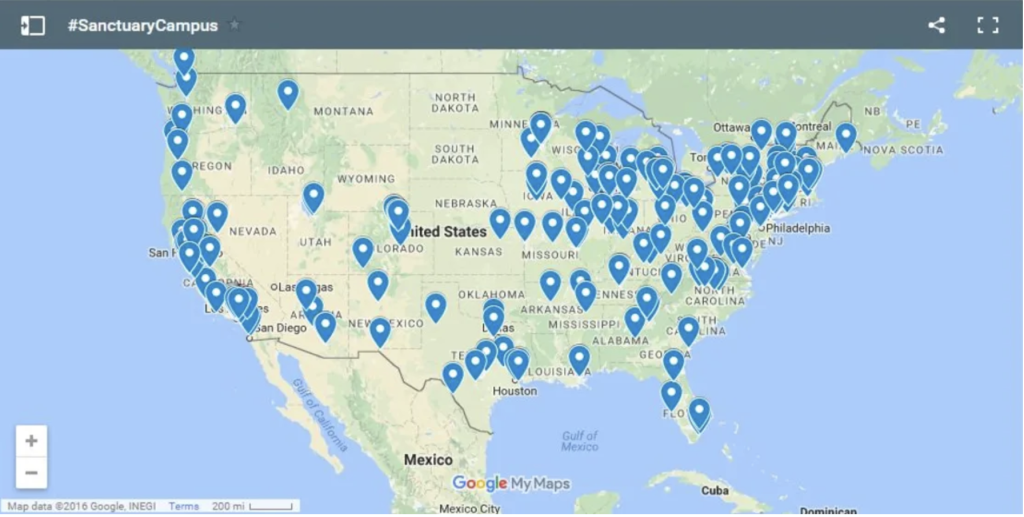
Now take a look at the sanctuary cities, counties, and states map below.
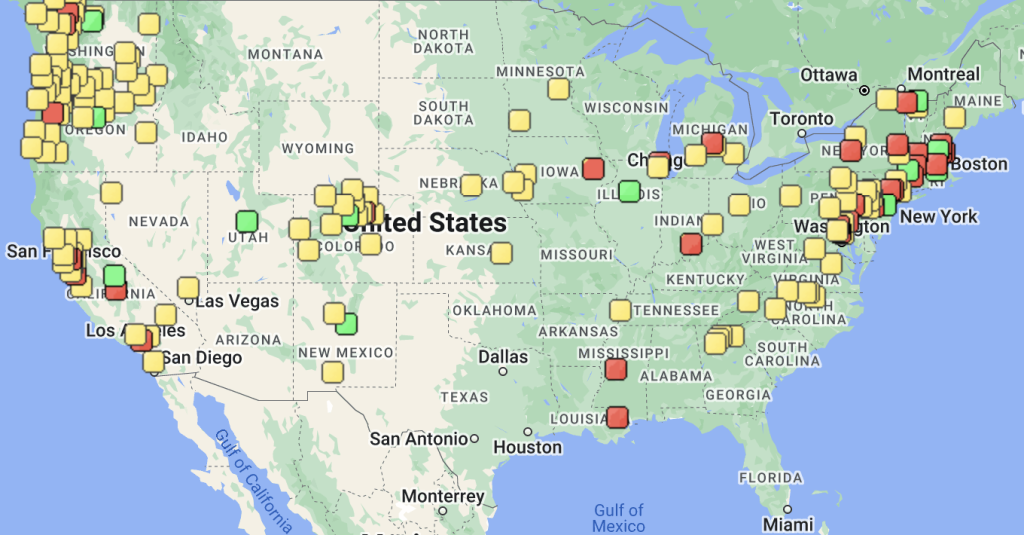
And finally, look at the map below of colleges and universities protesting the Israel-Hamas war as of April 2024. Green represents colleges that have had encampments and blue are non-encampment protests. Here is additional information and some updates on some of the campuses as of May 2024.
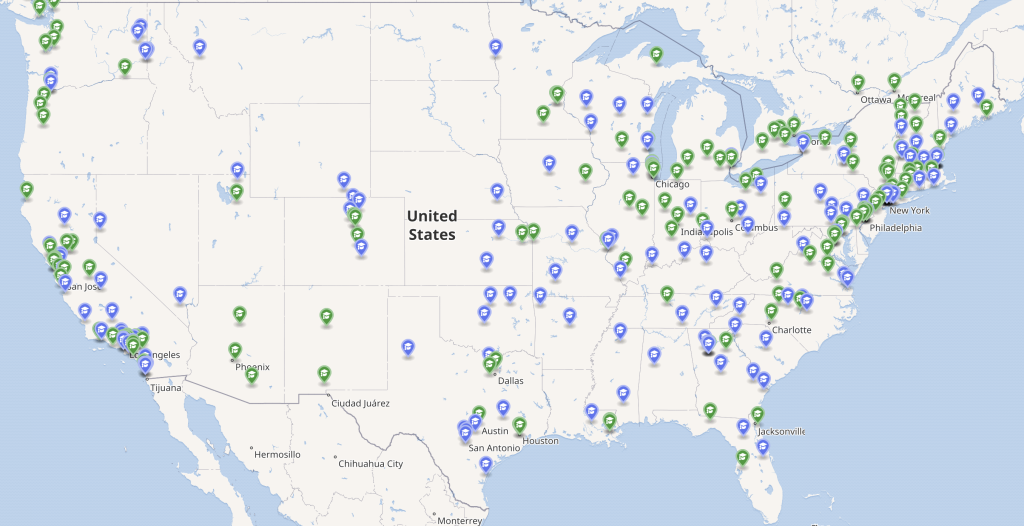
See the pattern?
What is The End Game?
That’s the million dollar question. Evidence shows that colleges and universities across the U.S. and other countries have students running protests, and in some cases encampments, demanding that they divest in Israel while at the same time big donors are threatening to suspend funds from these schools. This is putting a lot of scrutiny on how endowments are managed and where the money is going, which will ultimately lead to a shake up consisting of installing key players, a money grab that will be called “oversight,” policy changes and eventually legislative changes – all to benefit billionaires and private equity firms.
Evidence also shows that there is a lot underway regarding illegal immigrants being housed at colleges and universities, sanctuary campuses and cities protecting their anonymity, private equity firms such as Blackstone running the biggest student housing company in the U.S., Middle East and other foreign countries investing in U.S. student housing, the Welcome Corps setting up shop to provide assistance with housing, food, education, and medical needs, and big Gov operating with the UN to drive the immigrants through the border. It wouldn’t be hard for all of the single men ages 18-24 who are coming through the border to blend in around college campuses. This isn’t to stoke fear in anyone, and it wouldn’t make sense to carry out any violent activities near a campus if that is a strategic “home base,” but it is important for people to be vigilant and observant and acknowledge the potential of what is being created here. As previously mentioned, many have also been housed in hotels, shelters, converted retail, and government compounds.
In addition to this, they have been working on “innovation districts” or “smart cities” that are being built out around universities to eventually expand into cities and regions. Are these cover for strategic migrant housing for future events or do they intend to build these out beyond campuses? Clearly, colleges have been buying up real estate for mixed-use in and around their campuses, and they all want a satellite campus in D.C.
Part of this sure seems like another major transfer of wealth, whereby the billionaires continue to donate and dictate to the schools, the money gets funneled off through private equity firms, oftentimes investing in what the billionaires are already invested in themselves. Contributions to endowments are tax write-offs and universities are non-profits so there are no capital gains taxes. Billionaires are billionaires because they know how to work the system, move money, setup their own non-profits, dictate demands that benefit them to those they donate to, and funnel money overseas. They have long had a stranglehold on higher education and have created indoctrination camps – camps that they intend to turn into micro smart cities with augmented virtual reality and full digital control and surveillance. The bottom line is, they want control of all assets, information, and people.
Private equity firms are also buying up hospitals and the top student housing companies also own and/or manage senior housing, single-family rentals, and medical clinics. Jeffrey Sachs wants everyone on universal healthcare. Just imagine what that would like in a world where they already obliterated the healthcare industry during the plandemic.
The affordable housing situation, albeit helpful to some families in need, is a trap to get everyone reliant on big Gov and they are expanding it at a rapid pace. The “build-to-rent” platform has investors coming in from every angle and with the local and federal governments expanding on vouchers, changing zoning and regulations, the entire housing industry is shifting, which we’ve long warned about.
There is a book I have yet to read, however, I am told it is excellent, and it really hits the nail on the head with what this report is talking about. The book Plunder: Private Equity’s Plan to Pillage America, by Brendan Ballou, breaks down how firms like Blackstone, Carlyle, and KKR are among the largest employers in America and hold assets that rival those of small countries. He explains how private equity has reshaped American businesses while reducing quality and cutting jobs, and how they buy up companies and real estate using little of their own money while leaving many companies bankrupt. The book covers everything from how private equity uses other people’s money, how they profit, the end of homeownership, poor care in nursing homes and health care, and much more. He also explains how arms of the government are assisting with this takeover. Part III consists of how to stop them, what we must do, and an agenda for reform.
Hopefully this report shines a light on several agendas taking place while smokescreens and distractions are carried out at enormous scale. This provides the groundwork for future observations and evidence. People should do their due diligence in determining who to invest with and what to invest in and stop financing the criminal syndicate that has been running Israel. Those selling homes will hopefully sell to a family rather than these big firms trying to buy them up, and those renting homes should rent from individual owners rather than management companies. College students should be aware of their surroundings, pay attention to who their neighbors are, and not get sucked into the indoctrination and technological “districts” being built so they can be lab rats for the rest of the world.
Forewarned is forearmed. Stay vigilant, stay strong, and stay sharp. Above all, don’t feed the enemy – feed your soul.
Download this full report in PDF format from the Bookshop >
This report is sponsored by The Solari Report.
Corey Lynn is always working to bring solutions to people. Be sure to check out Corey’s Digs’ Partners who provide a variety of quality products and services ranging from health, meat and fresh foods, wealth, security, privacy, organic seeds, USA made products, and more! Visit Shopping Club Freedom for fantastic prime and high choice beef, plus hundreds of non-toxic household and personal care products made in the USA.

Subscribe to Corey’s Digs and don’t miss a Dig!










13 Comments
Gram
Stunned. The web of control, deceit, greed, dominance etc is so utterly vast, and laid out so clearly by your excellent research and reporting; Corey. it is nearly inconceivable. But already knowing a bit about how those at the top of the power pyramid view the world and those under’ them and their spells, I CAN conceive it. Stunned.
Reply
Now look around to find any MSM reporting on the issues. Pack a lunch and a lantern. You’ll need them.
Skip
Is it all for billionaires benefit or is it to tighten control, enslave, harvest and eliminate as the Anaconda does with its prey
The noose tightens.
These non-specific billionaires need to be identified more specifically and individually if they are to seriously be countered. Otherwise, one is flailing about aimlessly. Identify the target. Aim straight at the target.
Corey Lynn
See my other reports with hundreds of names: https://www.coreysdigs.com/global/coreys-digs-library-catalog-volume-11/
The 3-part Laundering with Immunity series breaks down their pyramid of players
The 4-part Global Landscape on Vaccine ID Passports lists 580 players involved
Same players in nearly every agenda. In this specific report it’s the universities working with the private equity firms and the billionaire donors. Each university or college can be easily looked into to find their list of donors.
Hope this helps.
Gram
Skip – Yes and yes. Those few who control the many have constructed all the systems around them — to protect THEM. They are not breaking the law, their laws. They write the laws for foundations, they select politicians and judges to support their laws. The Matrix is Their Matrix.
Skip
The law is what those in control say it is now. Who is going to stop their police force Their lawyers Their civil servants and their mega corporations. you saw how it went during the covid phase of this operation.
Therefore, if you cant beat them, dont join them. Homeschool. find a way to exist outside their matrix. It is harder than imagined since their money and credit is so deeply insinuated into so so much. Maybe when this matrix blows it will break enough to allow a reset from the remnant but not the WEF kind.
Esther Cook
The target is not the bodies of the evil billionaires. “For we wrestle not against flesh and blood, but against principalities and powers in the high places.”–New Testament
Also, I am not sure that “fighting the enemy” is as important as creating what we DO want.
Skip
I agree completely. you have to have something to fight for. Make the world that you want to see.
Skip
Thanks. Miss yours and Edges podcasts. I found the old report on SEL very revealing.
Gerry_O'C
Credit due, Corey! Absolute tour de force! By the way, towards the beginning, at point 6 in parentheses under the head ‘In simple terms’ i believe u meant to type while ‘implementing’ rather than why. Those typos drive me nuts, when i’m writin anything! Must have taken endless hours researching and drawing all of this together. I’ll have to return to it, and look closely at it. You’ve obviously uncovered their prototype, and it’s frustrating how advanced is it’s implementation. It makes one sick to their stomach. Had u ever considered writing on substack? Folk need to read this. I’ll link to it, on mine, and share where i can. Soon as possible. In the meantime here are a couple of quotes from one Michael J. ‘Crocodile’ Dundee of ‘Crocodile Dundee’ film, 1986 fame, and shed some philosophical humor on these fraught times!… https://m.imdb.com/title/tt0090555/quotes/ …
Richard Mason: New York City, Mr. Dundee. Home to seven million people.
Michael J. “Crocodile” Dundee: That’s incredible. Imagine seven million people all wanting to live together. Yeah, New York must be the friendliest place on earth.
Michael J. “Crocodile” Dundee: Well, you see, Aborigines don’t own the land.They belong to it. It’s like their mother. See those rocks? Been standing there for 600 million years. Still be there when you and I are gone. So arguing over who owns them is like two fleas arguing over who owns the dog they live on.
Diann Bowen
Nice little turdbit
“Hunter Biden actually owns 10% of a company called Eplata, which is a micro financing loan company for illegal immigrants coming up through the southern border.”
“At the same time, the Biden Administration Justice Department put out a notice telling the banks that they would, that the Justice Department would take legal action against any bank who refused loans to illegal immigrants. Meanwhile, the first son is, has an equity investment in a company that profits off those very loans”
h/t @WallStreetApes
https://x.com/wallstreetapes/status/1801350706785620027?s=46
👇👇👇👇👇👇👇
John Carter
Brilliant analysis.
Thank you!
Gerry_O'C
… the latest from the WEF, their hypocrisy is embarrassing, and u’ve their agenda well covered Corey!… https://lionessofjudah.substack.com/p/while-you-were-distracted-wef-pushes?utm_source=post-email-title&publication_id=581065&post_id=146090796&utm_campaign=email-post-title&isFreemail=true&r=1uo2p8&triedRedirect=true&utm_medium=email …